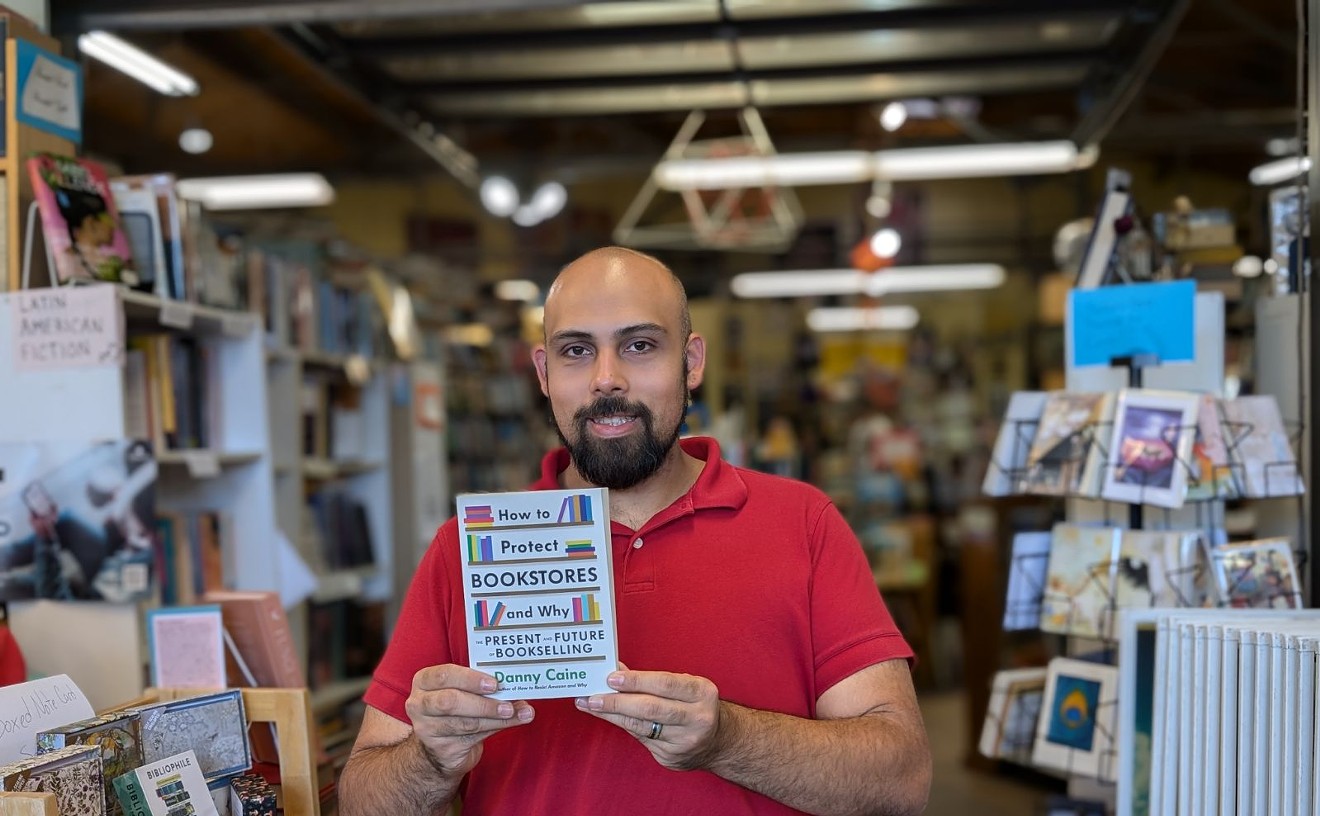Symbols of the Big Bang, at the Singer Gallery of the Mizel Center for Arts and Culture, is riveting, and it's so heavily layered with meaning that it would take either artist Vitaly Komar or Alexander Melamid to give a full explanation. Lucky for us, Komar is in town on Thursday, October 23, and will be presenting a lecture at the Mizel Center at 7:30 p.m.
Moscow-born Komar and Melamid, who are among the most significant Russian emigré artists in this country, began collaborating in 1965. In every project, they share a premise on which they base their series, but each piece is done individually by either Komar or Melamid. This act of collaboration was a response to American pop art, which was seen as outrageous in their homeland, because everything but the officially sanctioned socialist-realist style was illegal. As a result of that anti-art atmosphere -- and Soviet anti Semitism -- the artists left Russia in the 1970s. They went to Israel and, soon after, to New York, where their traditional painting skills came in handy, since representational imagery was coming on strong at that time.
Despite emigrating to get away from politics, however, politics seem to have followed them everywhere -- even to Denver. In 2000, they were awarded a commission to create a work for the Alfred A. Arraj United States Courthouse downtown. Using his power to veto, U.S. District Court Chief Judge Lewis Babcock, a member of the art advisory committee, rejected their initial idea, a painting that included a columbine. The blossom is Colorado's official state flower, but, sadly, it also references Columbine High School. Komar and Melamid then put forward the idea of painting the ceiling in a flag motif, using images of the constellations instead of stars. Babcock also rejected this idea, and the artists were paid and dismissed. Artists from Russia being censored in the U.S. is an irony worthy of Komar and Melamid.
And the artists do have a reputation for being ironic, but in Symbols of the Big Bang, they say they are being sincere. One dominant theme of the show is how the Star of David can be elegantly entwined with a swastika -- which does seem a bit ironic -- or with any one of a cast of ancient symbols.
As might be expected, the artists' pieces are done at the highest level of technical ability. The mixed-media collages have an incredible sense of depth, and the interplay of lights and darks -- so appropriate in a show called the Big Bang -- is absolutely masterful. And if the drawings are good, the two important paintings, both titled "Symbols of the Big Bang," are even better.
The Big Bang pieces originated with Komar's near-death experience following cardiac surgery. When he awoke after an administered electric shock, he thought he was in the hospital where he was born. "I had a chance to re-experience that primal flash of light, my personal big bang." Combining this idea of the big bang -- referring to the light overcoming the darkness -- the drawings could be read as symbolizing the triumph of the Star of David over the swastika and the other less politically charged symbols.
This compelling show originated at the Yeshiva University Museum in New York, and when Singer director Simon Zalkind heard about it, he knew he wanted to bring it to Denver. So when he was talking about the show with Mina Litinsky -- owner of the Sloane Gallery, which is Komar and Melamid's Denver representative -- he mentioned how much he wished it could be presented at Singer. That was all he needed to say. "Mina did everything," Zalkind explains. "She was like a fairy godmother who waved a magic wand."
Litinsky also facilitated a second Komar and Melamid show, which is installed in the balcony gallery, opposite the elevator. Called The Testament of the Priest and Teacher, the show lays out a new book the two have written and illustrated, which tells the story of their leaving the Soviet Union. One tongue-in-cheek aspect of these mixed-media pieces -- and there are many -- is the style, which apes that of Russian Orthodox icons.
Excellent as these shows are, Zalkind is still reeling and "disheartened" by the recent unexplained dismissal of the director of the Mizel Center, Joanne Kauvar. "Her belief in beauty and in the value of contemporary Jewish culture inspired all of us to do the best we could do. I treasure the time I had to work under her direction and envy whoever next has the opportunity to work with her."
There are changes afoot at the University of Colorado, where the CU Art Galleries have been renamed the CU Art Museum. "We wanted the name to reflect the fact that we're a collecting institution," says museum director Lisa Tamiris Becker. "We have 5,000 works of art in our collection, but they've been in storage for years, and now there's a renewed interest in getting pieces back out on the campus."
Becker has loaned several works to the Norlin Library, notably a newly acquired painting by Elizabeth Murray, but I hope she is cautious -- because putting the art out also puts it in danger of fading (especially true of prints -- and the CU collection is lousy with them) and possible theft.
A less controversial change for CUAM is the return of a faculty show, which Becker's predecessor, Susan Krane, had banished. "When I was hired last year, there was the desire to have a faculty show," Becker says, with a flair for the understatement. The result of that desire is the 2003 Faculty Exhibition.
The show does a good job of representing the tremendous diversity of media and styles embraced by the CU art department. There are a number of strengths displayed, including ceramics, digital media, installation, video and, of all things, representational painting.
In ceramics, there are the marvelous wall sculptures by Scott Chamberlin, which are related to those in his solo at Robischon. Also cool are the two flower-based floor sculptures by Kim Dickey.
The digital-media displays include the works of Jim Jonnson and Ken Iwamasa, best known for their compositions in other mediums. In a related though distinct vein are the three photo-based digital images by Albert Chong, which explore his Jamaican and Chinese heritage.
There are several installations, notably the wonderful mirror-covered barricades by Yumi Janairo Roth and the absolutely stunning steel-and-tire arrangement by Garrison Roots. True, the Roots owes a debt to Bruce Nauman, but so what?
There's video, video everywhere. Now, I'm not a big fan of fine-art video -- I like television too much, and it's typically better -- but it's hard not to be impressed by Mark Amerika's "Codework." Installed in its own mini-theater, the piece incessantly flashes and seems to be completely abstract and non-narrative, despite the repeated image of what looks like a male head and the female voiceover.
Finally, there are those wonderful contemporary representational paintings. First is the pair of signature landscapes by Chuck Forsman that are just edgy enough to look surreal. Next is the quartet of Jerry Kunkel paintings, including "Facts," which are still-life scenes with all the verisimilitude of photos.
The 2003 Faculty Show at CUAM reveals not only the art department's strengths, but also its weaknesses. And the big shortcoming, as far as I can tell, is that, aside from gifted printmaker Clint Cline, there's little abstraction going on. Representational imagery, on the other hand, is the style of choice for several teachers, and, to be honest, half of them aren't very good at it.
Someone who is very good at what he does -- in this case, abstract painting -- is the subject of a handsome solo at the O'Sullivan Arts Center on the campus of Regis University. Steven Altman: Passions, Cynicisms, and Conundrums displays the artist's new paintings, which include felt, something he began working with a couple of years ago.
At first the felt really didn't work; Altman's paintings, which had formerly been extremely elegant, all of a sudden looked funky -- which I didn't like as well. But since Altman is a father, I chalked up the whole felt thing to insanity brought on by being in the constant presence of young children. Well, he's apparently come to his senses, and his paintings are becoming elegant again. (Maybe the kids are finally off at school?) The new paintings still are not as beautiful as his efforts from the 1990s, but the latest works do make the pieces of the past couple of years look transitional -- which makes me feel a lot better.
There are two strong points to any Altman painting, whether successful or not: exceptional drawing and sophisticated color choices. He has an instinctive sense for drawing, and his colors, laid out in broad, luxurious fields, are gorgeous. Check out that pink and orange combo in "Trouble With Perfection," the painting used on the O'Sullivan poster, or that incredible sea-blue-green in "Don't Know."
The O'Sullivan is an impressive facility, but there's no real director or staff to support it, and as a result, none of the shows there get much attention -- not even those that deserve it, like the wonderful Steven Altman.
I'd like to add a sense of urgency to my recommendations this week, because instead of discussing shows that have recently opened -- the ordinary topic of this column -- I'm plugging ones that are on the verge of closing. And that means, of course, that you'll need to go soon if you want to catch them before they're history.











